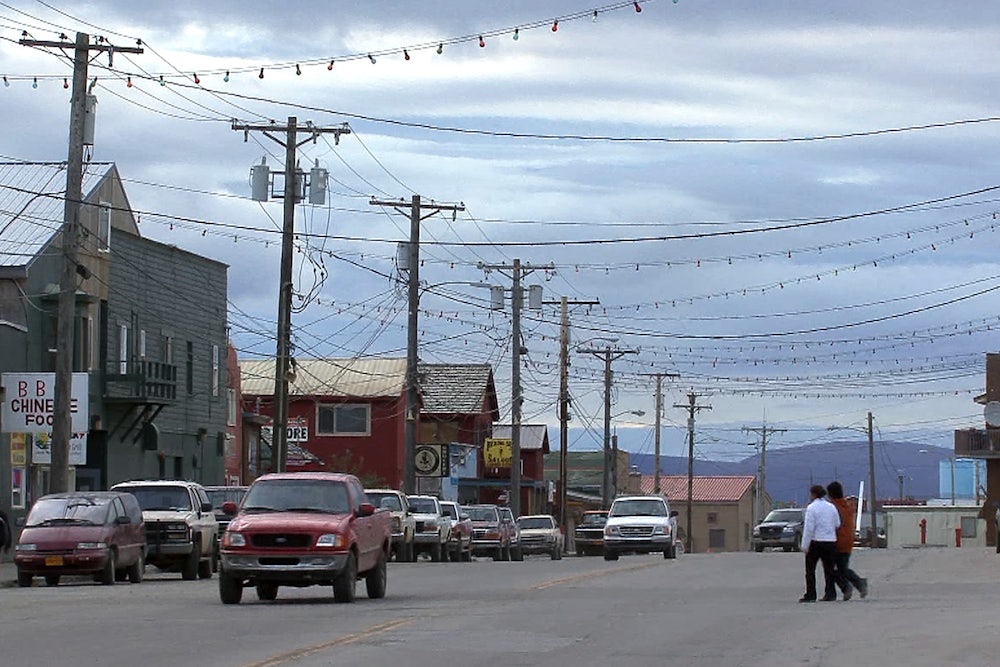Nome, Alaska—population 3,600, myself included—is one of the most remote places in North America. Entirely disconnected from the continent’s road system, it has two gas stations, two pizza joints, half a dozen sled-dog teams, and no traffic lights. And soon, Nome’s diminutive harbor, at the upper reaches of the Pacific Ocean, will be able to accommodate any U.S. military vessel smaller than an aircraft carrier.
With funding from the 2021 Bipartisan Infrastructure Law, the Army Corps of Engineers allocated $250 million last year to build the northernmost deepwater port in the United States. Spending a small fortune to make Nome a fully equipped naval rest stop is emblematic of a larger trend reshaping the High North. An unprecedented infrastructure boom, made possible in part by global warming, is transforming the region into an increasingly militarized and industrial landscape—one where the extraction of natural resources and degradation of the environment are accelerating in tandem.
This isn’t the first time the federal government has sought to build a deepwater port in remote Alaska. In the 1950s, the U.S. Atomic Energy Commission surveyed the nation in search of creative ways to use nuclear bombs in infrastructure projects. Proposals included bombing the earth to make way for roads, railways, mines, and canals, as well as detonating buried nuclear explosives to extract oil and gas from shale formations—nuclear fracking. One project proposed using a handful of nuclear bombs, each one more than six times more powerful than the bomb dropped on Hiroshima, to excavate a harbor at a site 250 miles north of Nome. More than half a century after that plan was scrapped, the U.S. is finally getting its deepwater port in the High North.
Similar stories echo across the Arctic these days. Chinese and Australian mining firms are prospecting Greenland in search of rare earth minerals. In Russia, President Vladimir Putin has directed a massive Arctic investment program, trying to reduce the Russian economy’s dependence on Europe by pivoting toward Asia. For years, Russia has been building up its fleet of nuclear-powered icebreakers, with hopes of keeping the Northern Sea Route open year-round to ship liquefied natural gas to Asian markets via the Arctic Ocean. In Alaska, the Department of Defense just awarded a $38 million grant to a graphite mine near Nome, accessible only by helicopter and worryingly close to the Iñupiaq village of Teller.
To a certain extent, history is repeating itself. The Arctic has been a resource frontier for centuries. Before fossil fuels came into widespread use in the late nineteenth century, whales were slaughtered for their blubber—the primary fuel used in oil lamps across Europe and North America. When large whales were wiped out in temperate waters, whalers pushed into the Arctic and Southern Oceans. A few decades later, the Arctic became the site of a series of gold rushes. In the twentieth century, the discovery of oil and gas across the High North led to waves of investment. During the Cold War, military installations were built and later abandoned, including the decommissioned radar station that overlooks the Port of Nome.
Far from being a pristine landscape, the Arctic is riddled with evidence of this history. Rusted mining equipment, spilled toxins, and abandoned locomotives are everywhere, if you know where to look. The Yukon River, which flows 2,000 miles from Canada to Western Alaska, dumps up to five tons of mercury into the North Pacific each year—the remnants of a gold rush that ended over a century ago. On St. Lawrence Island, not far from Nome, 180,000 gallons of diesel were spilled at a Cold War–era military base in 1969, destroying a Siberian Yupik hunting and fishing camp.
But this most recent rush to the Arctic is decidedly different from previous ones, pushing further North and seeking out different resources. I spoke with Rick Thomen, a climatologist at the University of Alaska Fairbanks who enjoys a certain celebrity status in the state. “In some significant sense,” he told me, “we can say that the construction boom is entirely climate change driven.”
Projects that were uneconomical in the twentieth century now pencil out favorably. This is particularly true as sea ice retreats and thins, offering longer periods when the oceans are navigable. The sea outside Nome is still frozen for several months each winter, but the ice arrives later and melts earlier. According to Thomen, projects such as the Nome port expansion bet on continued global warming; there is a “near certainty that in the coming decades, open water season will lengthen beyond what it is now.”
Conversations about Arctic shipping usually focus on the Northern Sea Route (over Asia) or the Northwest Passage (over North America). Depending upon conditions and destinations, these routes can save several days of sailing time compared to traveling via the Suez or Panama Canal.
But when I raised this with Mia Bennett, an assistant professor of geography at the University of Washington, she cautioned against viewing the Arctic transit routes as the main story. “More importantly,” she told me, “increasing maritime accessibility makes it easier for destinational shipping in the Arctic—meaning it’s easier for vessels to come in and bring Arctic resources out to market. That’s where investors’ interests lie, rather than using the Arctic as a shortcut for container shipping between Asia and Europe.”
Less sea ice means that a mining or fossil fuel operation might have access to open water for long stretches of the summer, winter, and fall, whereas in the twentieth century, sea ice might have allowed access for only a couple of months each year. The last couple of decades alone have seen a massive uptick in maritime traffic in the High North. In 1998, just two vessels sailed the Northwest Passage. In 2023, 42 ships made the journey.
Although Alaskan politicians are quick to tout the infrastructure boom’s economic benefits, the reality is more mixed. “The investment is going to where it always has gone in the Arctic’s economic history, which is to extractive sites,” Bennett told me. Bennett emphasized that, although climate change is partly responsible for fueling new development, the building spree has followed a centuries-old pattern of unequal development. “There’s still so much underinvestment in infrastructure that serves local purposes, whether that’s hospitals, schools, [and] especially higher education facilities in the North.”
Alongside the rush to claim natural resources and establish military presence, climate change is necessitating another infrastructure boom—safeguarding Northern communities that are among the most climate-vulnerable in North America. The Bureau of Indian Affairs estimates that protecting infrastructure in Alaska Native villages will cost at least $4 billion in the next half-century. As the Port of Nome project secures final permissions to begin construction next year, nearby Alaska Native villages—such as Shaktoolik and Shishmaref—are struggling to secure federal assistance to shore up coastal defenses or relocate to higher ground.
Back in Nome, I see the port expansion met with a mix of eagerness and trepidation. Businesses catering to tourists look forward to larger cruise ships, which already spill out hundreds of wealthy tourists with matching jackets during the ice-free months. But there’s also a distinct feeling of unease, rooted in the knowledge that this small town will soon be a geopolitical landmark in any Arctic military maneuvering.
Climate change has swung open the door for disaster capitalism to sprint “North to the Future”—Alaska’s state motto. But the new Arctic frontier shares the same blueprint as the old one, with colonial inequality and a privileged position for business. That hasn’t changed since the first whaling ships appeared on the horizon.










